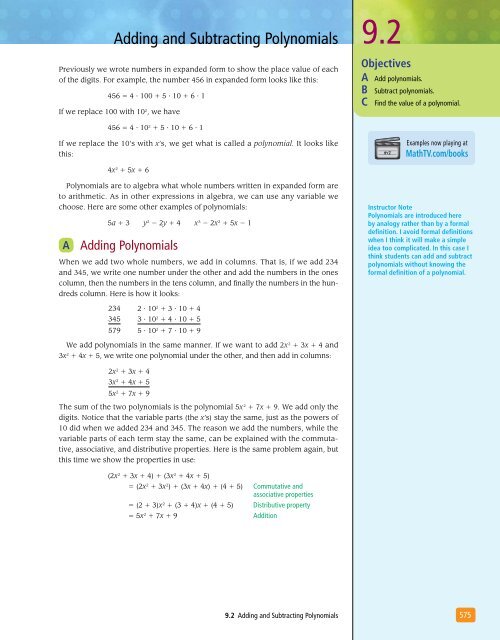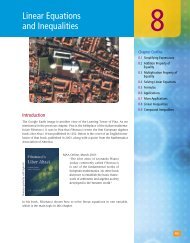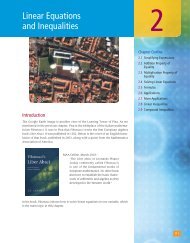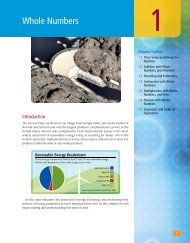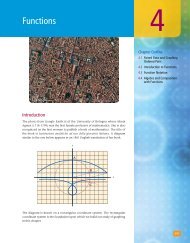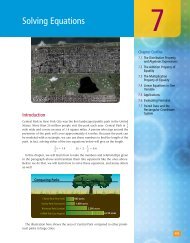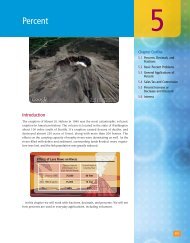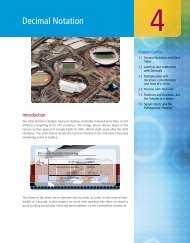Exponents and Polynomials - XYZ Custom Plus
Exponents and Polynomials - XYZ Custom Plus
Exponents and Polynomials - XYZ Custom Plus
- No tags were found...
Create successful ePaper yourself
Turn your PDF publications into a flip-book with our unique Google optimized e-Paper software.
Adding <strong>and</strong> Subtracting <strong>Polynomials</strong>Previously we wrote numbers in exp<strong>and</strong>ed form to show the place value of eachof the digits. For example, the number 456 in exp<strong>and</strong>ed form looks like this:456 = 4 ⋅ 100 + 5 ⋅ 10 + 6 ⋅ 1If we replace 100 with 10 2 , we have9.2ObjectivesA Add polynomials.B Subtract polynomials.C Find the value of a polynomial.456 = 4 ⋅ 10 2 + 5 ⋅ 10 + 6 ⋅ 1If we replace the 10’s with x’s, we get what is called a polynomial. It looks likethis:Examples now playing atMathTV.com/books4x 2 + 5x + 6<strong>Polynomials</strong> are to algebra what whole numbers written in exp<strong>and</strong>ed form areto arithmetic. As in other expressions in algebra, we can use any variable wechoose. Here are some other examples of polynomials:5a + 3 y 2 − 2y + 4 x 3 − 2x 2 + 5x − 1A Adding <strong>Polynomials</strong>When we add two whole numbers, we add in columns. That is, if we add 234<strong>and</strong> 345, we write one number under the other <strong>and</strong> add the numbers in the onescolumn, then the numbers in the tens column, <strong>and</strong> finally the numbers in the hundredscolumn. Here is how it looks:Instructor Note<strong>Polynomials</strong> are introduced hereby analogy rather than by a formaldefinition. I avoid formal definitionswhen I think it will make a simpleidea too complicated. In this case Ithink students can add <strong>and</strong> subtractpolynomials without knowing theformal definition of a polynomial.2343455792 ⋅ 10 2 + 3 ⋅ 10 + 43 ⋅ 10 2 + 4 ⋅ 10 + 55 ⋅ 10 2 + 7 ⋅ 10 + 9We add polynomials in the same manner. If we want to add 2x 2 + 3x + 4 <strong>and</strong>3x 2 + 4x + 5, we write one polynomial under the other, <strong>and</strong> then add in columns:2x 2 + 3x + 43x 2 + 4x + 55x 2 + 7x + 9The sum of the two polynomials is the polynomial 5x 2 + 7x + 9. We add only thedigits. Notice that the variable parts (the x’s) stay the same, just as the powers of10 did when we added 234 <strong>and</strong> 345. The reason we add the numbers, while thevariable parts of each term stay the same, can be explained with the commutative,associative, <strong>and</strong> distributive properties. Here is the same problem again, butthis time we show the properties in use:(2x 2 + 3x + 4) + (3x 2 + 4x + 5)= (2x 2 + 3x 2 ) + (3x + 4x) + (4 + 5) Commutative <strong>and</strong>associative properties= (2 + 3)x 2 + (3 + 4)x + (4 + 5) Distributive property= 5x 2 + 7x + 9 Addition9.2 Adding <strong>and</strong> Subtracting <strong>Polynomials</strong>575


